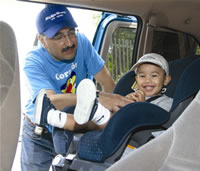The U.S. Department of Transportation reports that human factors cause or contribute to more than 90 percent of serious crashes. In the pre-crash stage, drivers can try to avoid crashes by practicing safe driving. Drivers can help reduce the risk of injury in the crash and post-crash phases by always properly using safety equipment such as safety belts. Ford Motor Company provides information, educational programs and technologies to assist in promoting safe driving practices.
Ford continued its commitment to educating young drivers about safer driving in 2006 and 2007 through Driving Skills for Life, our national education program for teens. This program earned Ford the 2007 Traffic Safety Achievement Award for Community Service from the World Traffic Safety Symposium at the 2007 New York Auto Show. Driving Skills for Life provides outstanding learning tools, including a DVD, printed materials and a newly redesigned Web site, to help young drivers improve their ability behind the wheel. The program was upgraded in 2006 to provide information about eco-driving, car care tips and information for mature drivers. A case study at the end of this section describes this comprehensive program in greater detail.
In addition, Ford continues to lead the industry in promoting safety belt use through its Beltminder™ system, an industry-first innovation that uses technology to influence the behavior of drivers and vehicle occupants by prompting them to buckle their safety belts. In the United States, and many regions outside of North America where regulations permit, Beltminder for the driver's seat is standard equipment on all Ford Motor Company vehicles. Ford has continued to expand the availability of Beltminder for the front passenger seat in its vehicles. In Europe, the Volvo S40, V50, C30, C70 and S80 have Beltminder for the rear seats as well. NHTSA has requested that the rest of the industry adopt systems similar to Ford's Beltminder, and EuroNCAP offers points for manufacturers who offer a Beltminder-type system. Ford licenses this proprietary technology to other vehicle manufacturers at no cost.
An important element of our research into human behavior is VIRTTEX, our VIRtual Test Track EXperiment simulator. In April 2005, Ford's industry-leading efforts with the VIRTTEX driving lab were recognized with an award from the World Traffic Safety Symposium. Ford has publicly released data from two major VIRTTEX studies – one on driver distraction and another on the effects of drowsy driving. The findings from these studies are being used to develop technologies to help drivers avoid crashes. These technologies are discussed in the Future Technologies section and the Volvo S80 case study of this report.

To promote more effective child passenger safety in Latino communities around the United States, Ford Motor Company Fund helps to support Corazón de Mi Vida, a bilingual and bicultural educational program. The program was developed by the National Latino Children's Institute (NLCI) and NHTSA. The NLCI and Ford Motor Company Fund join forces with local partners in various U.S. cities to inform Latino families, child care providers and the Spanish-speaking community about the important role that safety seats and safety belts play in saving children's lives.
Ford also has been working to research and help improve driver behavior factors on a global basis. In China, Ford is cooperating with the China Automotive Technology & Research Center and the Chinese Ministry of Public Security to launch a new project that aims to provide accurate and scientific data for research into road safety in China. As part of that project, Ford took part in a workshop in Shanghai in January 2007 that brought together road safety experts from the United States, Europe and China to exchange information and experience, as well as to define a road safety project that will help establish a "glide path" for rapidly reaching an accident reduction target.
Since 1995, Ford has been setting aside $20 for every Ford and Mazda vehicle sold in the Philippines for its road safety programs in that country. The funds are used to educate drivers and promote road safety through training programs, research and other road safety projects. The funds have also been used to create the R.I.D.E. program (Responsibility in Driver Education) – a series of road safety talks. After being successfully rolled out in 13 schools and seven Ford corporate accounts, and among Ford employees, the 2006 R.I.D.E. program was expanded to include pre-school and elementary students and a train-the-trainer program for teachers. The funds also made possible another road-safety first in the Philippines – giving child safety seats to Ford and Mazda customers.
In Thailand, Ford undertook a joint campaign in 2005 with its dealers on a road safety education program. Customers were invited to a Ford dealership to participate in the course, which was hosted by a well-known national motoring journalist and columnist. Ford Thailand also co-sponsored a road safety training campaign with the Red Cross, as well as a road safety education campaign and University Safe Drive.